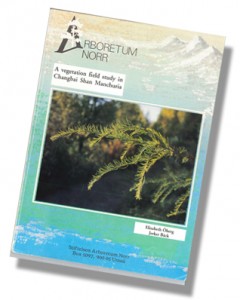
Rhododendron brachycarpum and Sambucus williamsii, north china red elder at the entrance to Changbai Shan.
Changbai Shan is a 2600 m high mountain in Manchuria located in the east of China where the country borders to North Korea. In 1990 the current arboretum manager Elisabeth Öberg and Jerker Bäck went to Changbai Shan on an scientific expedition. The mountain has very distinticive vegetation zones from about 700 m over sea level to the very top. One of their reasons for the trip was to follow different species ability to cope with the gradually harsher climate. (Download their interesting report by clicking on the link at the bottom of this page). Another part of the expedition was of course to gather seeds. Even though Changbai Shan is located quite a bit to the south (42°N bredd), the plants grow at a high altitude so there should be a lot of exciting species who can endure our northern climate.

Changbai Shan in Arboretum Norr, with newly planted manchurian ash, Fraxinus mandshurica in the foreground. There is also a Erman’s birch, Betula ermanii, right next to the stairs. It is a type with a very straight stem gathered in Kamchatka.
In 1995 the work was started by Elisabeth to make a Swedish variety of Changbai Shan in Baggböle using the data they gathered about vegetation zones etc. Today we have north china red elder, Sambucus williamsii, edible honeysuckle, Lonicera coeruela var. edulis, and korean roses, Rosa koreana, growing here and they all stem from Elisbeths original collections. In later years we have started complementing the collection with plants that have been gathered farther north in East Asia (mostly on Sakhalin and Kamtchatka). Mostly it’s species which also grew on Changbai Shan but this time they are gathered in a more northern provenance too make them more suitable for our climate here in Umeå. For example at the bottom of the stairs there are two alders gathered in Kamtchatka. Manchurian alder, Alnus hirsuta, and siberian alder, Alnus viridis ssp. fruticosa. Growing next to them are manchurian birch, Betula platyphylla, and Erman’s birch, Betula ermanii from the same place. Around the bench grows Actinidia kolomika, or kolomikta vine with its interesting green leaves that gets splashes of both white and pink. It is related to the classic kiwifruit, Actinidia deliciosa, and it also gets edible fruits, they are however much smaller and smoother then its big and fuzzy relative.

Tores staircase is named after Tore Karlsson in Baggböle who donated this piece of land to the foundation Stiftelsen Arboretum Norr and made this place a reality.
The whole ridge above East Asia is protected as a key habitat and we cooperate with the Swedish Forest Agency to preserve these diverse biotopes. We have been allowed to open up a small space in the key habitat for better access. It is the 60 m long, Tores staircase which stretches from Changbai Shan in East Asia, up to the fields on top of the ridge. From above you can have a better view of the key habitat or a closer walk back to the parking spot.
On both sides of the staircase the slope is not as steep as the surrounding area, so here we have planted mostly maples. Ussuri maples, Acer barbinerve, is growing with a ukurunde maple, Acer caudatum ssp. ukurunduense, which in its home in the east Asian forests grows in the undergrowth below bigger trees.

